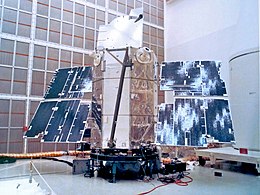astro.wikisort.org - Institution
The Orbiting Astronomical Observatory 2 (OAO-2, nicknamed Stargazer) was the first successful space telescope (first space telescope being OAO-1, which failed to operate once in orbit), launched on December 7, 1968.[2] An Atlas-Centaur rocket launched it into a nearly circular 750-kilometre (470 mi) altitude Earth orbit.[3] Data was collected in ultraviolet on many sources including comets, planets, and galaxies.[2][4] It had two major instrument sets facing in opposite directions; the Smithsonian Astrophysical Observatory (SAO) and the Wisconsin Experiment Package (WEP).[4] One discovery was large halos of hydrogen gas around comets,[4] and it also observed Nova Serpentis, which was a nova discovered in 1970.[2]
 Technicians in a clean room at NASA’s Kennedy Space Center in Cape Canaveral, Florida, check out the Orbiting Astronomical Observatory 2 before the mission’s Dec. 7, 1968, launch. | |
| Mission type | Astronomy |
|---|---|
| Operator | NASA |
| COSPAR ID | 1968-110A |
| SATCAT no. | 3597 |
| Spacecraft properties | |
| Manufacturer | Grumman |
| Dry mass | 2,012 kilograms (4,436 lb) |
| Start of mission | |
| Launch date | 7 December 1968, 08:40:09 UTC |
| Rocket | Atlas SLV-3C Centaur-D |
| Launch site | Cape Canaveral LC-36B |
| End of mission | |
| Last contact | January 1973 |
| Orbital parameters | |
| Reference system | Geocentric |
| Regime | Low Earth |
| Perigee altitude | 768 kilometres (477 mi) |
| Apogee altitude | 777 kilometres (483 mi) |
| Inclination | 35.0 degrees |
| Period | 100.30 minutes |
| Epoch | 6 January 1969[1] |
Celescope: Smithsonian Astrophysical Observatory
The Smithsonian Astrophysical Observatory, also called Celescope, had four 12 inch (30.5 cm) Schwarzschild telescopes that fed into Uvicons.[5] Various filters, photocathodes, and electronics aided in collecting data in several ultraviolet light passbands.[5] The experiment was completed in April 1970.[5] By the time it finished about 10 percent of the sky was observed.[5] The Uvicon was an ultra-violet light detector based on the Westinghouse Vidicon.[6] Ultraviolet light was converted into electrons which were in-turn converted to a voltage as those electrons hit the detection area of the tube.[7] There has been a Uvicon in the collection of the Smithsonian Institution since 1973.[6]
Wisconsin Experiment Package
The Wisconsin Experiment Package had eleven different telescopes for ultraviolet observations.[8] For example, there was a photoelectric photometer fed by a 16-inch (40.64 cm) telescope with a six-position filter wheel.[8] WEP observed over 1200 targets in ultraviolet light before the mission ended in early 1973.[4]
Spacecraft bus
The observatory was built in the shape of an octagonal prism. It measured about 10 by 7 ft (3.0 by 2.1 m) and weighed 4,400 lb (2,000 kg).[9]
See also
- Orbiting Astronomical Observatory
- Orbiting Solar Observatory
References
- McDowell, Jonathan. "Satellite Catalog". Jonathan's Space Page. Retrieved 12 October 2013.
- Joseph A. Angelo (2014). Spacecraft for Astronomy. Infobase Publishing. p. 20. ISBN 978-1-4381-0896-4.
- Gunter – OAO-2
- Orbiting Astronomical Observatory OAO-2
- High-Resolution Telescopes
- "Detector, Uvicon, Celescope". National Air and Space Museum. 2016-11-24. Retrieved 2018-01-24.
- "Detector, Uvicon, Celescope | National Air and Space Museum". airandspace.si.edu. Archived from the original on 2018-01-25.
- Wisconsin Experiment Package
- "OAO-2". Space Based Telescopes. Retrieved 2018-10-25.
External links
- OAO 2 observations of the Alpha Persei cluster
- OAO-2 Info and pics
- 50th Anniversary Overview of OAO-2 including video
Другой контент может иметь иную лицензию. Перед использованием материалов сайта WikiSort.org внимательно изучите правила лицензирования конкретных элементов наполнения сайта.
WikiSort.org - проект по пересортировке и дополнению контента Википедии